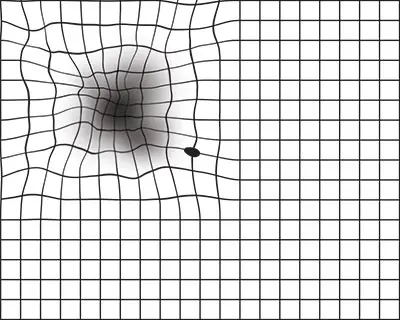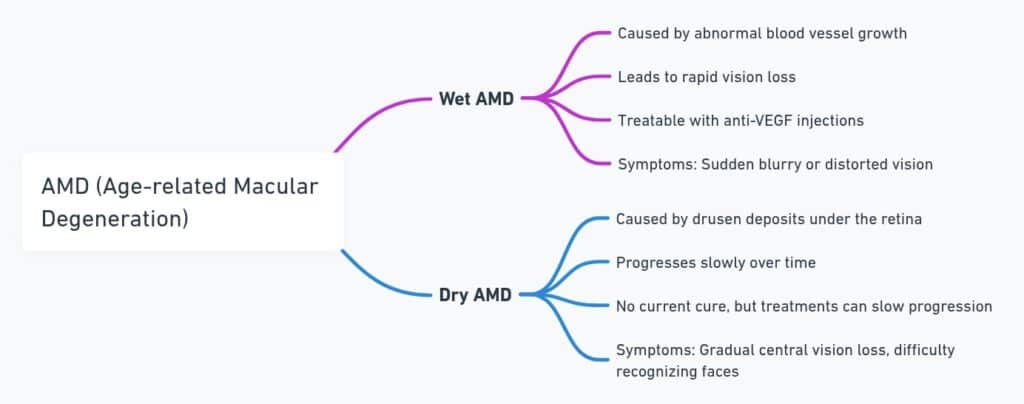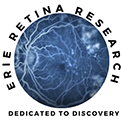

Age-related macular degeneration (AMD) is a leading cause of vision loss among individuals over 50, affecting the macula which is crucial for sharp central vision. In this detailed guide, we explore the essential differences between its two types—wet AMD and dry AMD—and offer guidance on effective management and preventative strategies. Vision loss can affect your daily life, increasing your risk of falling, and feel overwhelming. We currently have a variety of different Clinical Research Studies that offer treatment to patients with either wet or dry macular degeneration.
Wet and dry age-related macular degeneration (AMD) are two forms of AMD, a common eye condition primarily affecting central vision. Dry AMD, the more prevalent type, occurs when parts of the macula thin with age, and tiny clumps of protein called drusen grow, gradually blurring central vision. It usually progresses slowly and can sometimes lead to significant vision loss, particularly when it advances to a late stage known as geographic atrophy. Wet AMD, although less common, is more severe and progresses rapidly. It develops when abnormal blood vessels grow under the retina and leak fluid or blood, rapidly damaging the macula and leading to swift and severe vision loss if not treated promptly. Early detection and treatment are critical in managing both types, with wet AMD requiring more immediate intervention to prevent rapid vision impairment.
What is Dry Macular Degeneration?
- Prevalence: Dry AMD is the most common type, affecting 85-90% of those diagnosed with AMD.
- Symptoms: Look for gradual loss of central vision, difficulty in reading or recognizing faces, and the presence of drusen—tiny yellow deposits beneath the retina.
- Management: There’s currently no cure for dry AMD, but progression can be slowed with a diet high in specific vitamins and minerals as recommended by the AREDS2 study. Erie Retina Research offers several advanced treatment options.
What is Wet Macular Degeneration?
- Prevalence: Wet AMD is less common but more severe, and it is responsible for the majority of severe vision loss in AMD patients.
- Symptoms: Symptoms include distorted vision where straight lines appear wavy, rapid loss of central vision, and noticeable dark spots in the field of vision.
- Treatments: Effective treatments include anti-VEGF injections, which help reduce the growth of abnormal blood vessels in the retina, and laser therapy to seal off leaking vessels. Erie Retina Research offers several advanced treatment options.

Diagnosing Macular Degeneration
Accurate diagnosis is key to managing AMD effectively. Tools commonly used include:
- Amsler Grid: This simple test detects vision abnormalities related to the macula. We have one you can print off here
- Optical Coherence Tomography (OCT): Provides detailed images of the retina, allowing doctors to see changes that may indicate wet or dry AMD.
- Fluorescein Angiography: A specialized test that uses a dye to illuminate blood vessels in the retina, highlighting abnormal areas.

Preventative Measures and Lifestyle Adjustments
Both types of AMD can benefit from lifestyle adjustments that may help slow the disease’s progression:
- Healthy Diet: Eating a diet rich in leafy greens and fish provides nutrients that can help protect your vision.
- Exercise and Health Management: Regular physical activity and managing health conditions like hypertension and cholesterol can reduce AMD risk.
- No Smoking: Smoking significantly increases the risk of AMD, so quitting can greatly benefit your eye health.
Erie Retina Research: Leading Care for AMD and More At Erie Retina Research, we are dedicated to providing top-tier eye care and access to cutting-edge treatments for individuals with both wet and dry macular degeneration, geographic atrophy, and many other eye diseases. Our comprehensive approach ensures personalized care plans tailored to each patient’s specific needs.

About Dr. Almeida Dr. David Almeida, founder of Erie Retina Research, is a renowned specialist in retinal diseases. With his extensive background and commitment to innovation in eye care, Dr. Almeida leads a team of experts focused on advancing treatment options and improving patient outcomes.
What is a Clinical Trial? A clinical trial is a research study conducted to evaluate the safety and effectiveness of new treatments, medications, or medical devices. These trials are essential for developing new medical therapies and determining their effects on human health. Participation in clinical trials is often free because the sponsoring organizations, which can be pharmaceutical companies, academic research institutions, or government agencies, cover all associated costs. They provide the treatment, monitor health outcomes, and manage all study-related medical care at no charge to the participants. This approach not only helps to advance medical science but also allows participants access to new therapies and expert medical care that might otherwise be unavailable to them.

To Conclude:
Understanding the differences between wet and dry macular degeneration is crucial for early detection and effective treatment. Regular eye exams are vital, especially for those over the age of 50 or those with other risk factors for AMD. If you’re concerned about AMD or need more information on managing the condition, visit Erie Retina Research or your local retina specialist for expert care and advice. Don’t hesitate to contact us to schedule an eye exam or consultation. Protect your vision by staying informed and proactive about macular degeneration. We also offer Virtual Retina Second Opinions if you are out of town but have questions.








